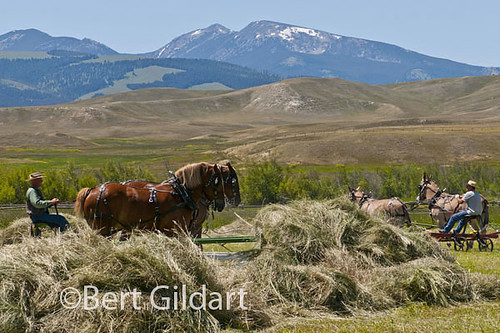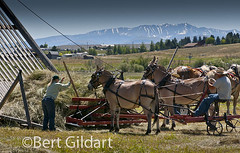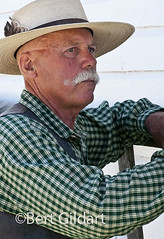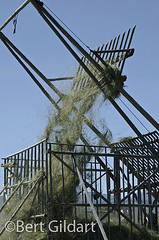Beautifully Matched Horses Simplify Hay Gathering at Historic Grant Kohrs Ranch
©Bert Gildart: The horses were all beautifully matched pairs and were well trained for the job at the Grant Kohrs Historic Ranch in Deer Lodge, Montana.
“Raise your foot,” said one of the team drivers in a quiet way, reminiscent of the protagonist (Robert Redford, remember?) in the movie, Horse Whisperer. “Step left.”
The job at hand was a multi-tasked one and the horses responded on cue. Horses and the team driver were collecting hay already pushed into windrows, but to now be pushed again with a horse-drawn buckrake to a unique farming implement known as the beaverslide. When the job is complete, ranchers will have created a pile of hay that looks like a huge breadloaf.
ORIGIN OF BEAVERSLIDES
Beaverslides originated in the Big Hole country, and Jay Nelson provided an initial introduction for me to the procedure, explaining the expediency of using beaverslides with horses. Nelson had encouraged me to take in the annual demonstration held at the Grant Kohrs Ranch, where I could see well trained horses in use.
First hay is assembled in the slide at its base in a section known as beaverbasket where workers distribute the hay horses have pushed in. Cables are attached to the basket and then string out to the harnesses of another set of powerful horses. On command, the pair moves forward and the beaverbasket begins to rise. When it reaches the top, the hay falls off and begins to accumulate into a growing pile.
HAY WAS PERFECT
“The hay couldn’t be better,” one of the old time ranchers told Janie. “It’s not the least bit wet, and if it were that would make the job more difficult, for it would be heavier.”
Horses (and one set of mules) working the fields with the drivers were perfectly matched Belgians and Percherons, a form of draft horse. In the old days, ranchers who used such horses (and mules) were proud of the teams, and as Janie’s new ranch friend told her, “Families were proud of their teams in the same way people today are proud of their cars.”
Teamster Kai Christensen, beaverside showing hay being deposited into basket, ranch girls spread hay to facilitate growing “loaf of bread.”
Haying at the Grant Kohrs Ranch is conducted in part to help preserve history. But it is still used in the southwestern part of Montana, in part because it is still an economical way to gather hay. Perhaps, too, the procedure provides a bit of nostalgia, the longing for a more simple way of way of life that is devoid of mechanization and that still relies on the use of beautiful draft horses.
TEAMSTERS
Ironically, one of the teamsters was Kai Christensen, a man whom I had met 25 years ago on a five-day wagon trip through the lower Flathead. Kai was one of the several teamsters Janie and I had enjoyed watching. He handled his horses well, and detailed for me the patience required to help his Belgians overcome the intimidation they felt as they approached the beaverslide. As well, Kai and I recalled the highlights of the trip we made years ago, and seeing him turned out to be yet another bonus in traveling throughout Montana, as Janie and I have been doing.
———————————————————————







